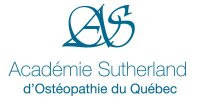I wanted to share the richness of my experiences as an osteopathic student at the ASOQ. The philosophical part of my education shaped and touched me in ways I did not expect. Under the guidance of the school’s pedagogical director, Guy Voyer, DO, I began to find a new way to look at disease and the functioning of the human body.
That journey into the philosophy of traditional osteopathy touched many aspects of my personal and professional life.
To look at the world from a wide lens, taking in all the elements of its experience and not isolating one thing, is the essence of artistry. It is from this perspective that Guy Voyer told us to began as students. Even when reading our anatomy textbooks he told us to skip over the part about what an organ, fascia, nerve or vessel was by itself. He wanted us to study the descriptions of what it touched, what went through it, by or around it. Only the relationship with all other things is what matters when we are in the business of freeing up all structures for optimum functioning. How true that is in all elements of human experience. So began the journey of how this macroscopic view began to shine through my work with patients and I began to change because of it.
Guy had us feel the many layers of the human body, working with the fascia, the bones, the vessels and the fluids. They cannot be separated out from each other, but they can be palpated appreciating their different characteristics. Then they can be used for the art and the science of diagnosing and treating the condition of the patient. In osteopathy, this is a process that is not linear. Diagnosing and treating happen at the same time. The human body is ever changing and each contact that we make with our hands affects the patient in many ways. For example, Guy taught us how to be very efficient and effective to reinstate proper biomechanics of the body, so that physiological function returns to normal. Then the osteopath can continue their job of not just adjusting bones, but normalizing fascial restrictions, balancing the central nervous system, following endocrine chains and harmonizing the global primary respiratory mechanism. This mechanism is a scientific, well defined process that connects all systems and is in relationship with the other biorhythms of the body. The extensive study and understanding of this mechanism is the cornerstone of osteopathy and the traditional osteopathic program at the ASOQ honors this fully.
My osteopathic education at the ASOQ has given me many tools in my therapeutic toolbox, but most importantly an overall philosophy from which to work. My practice is overflowing from referrals from happy patients who say the work is so efficient and the positive results are clear. Osteopathy is the fruit of cooperation.
HOW I SEE ASOQ
As a recent graduate of the Academie Sutherland d’Osteopathie du Quebec (ASOQ), I would like to pass on my reflections on this school, the curriculum and the courses.
In my first year of studies at the school, I was impressed with the curriculum and course outline. I did my B.Sc. in Physiology at McGill and at a theoretical level, the things we were learning in that first year was already a step above what I learned in my entire undergraduate degree. As the years progressed we learned in-depth anatomy, physiology, semiology, radiology which always complemented the manual osteopathic techniques and approaches we were practicing.
The time given to the practical component of osteopathic treatments is a great strength of the school. Once the anatomy is duplicated in the mind of the osteopath, there are many different ways to follow the patient to correct a given lesion. We were presented with many options, many avenues and the many ways that the whole human body is in constant inter-relationship with all its parts. There were no recipes given, but an encompassing philosophy which allowed students to adapt and create a treatment plan that allowed new emergences and a creative approach.
I support the school and its pedagogy, and I hope to see this education flourish and prosper.
Sincerely,
Jennie ANSTEY, D.O.
Regroupement de témoignages de diplômés et d'étudiants concernant l'Académie Sutherland d'ostéopathie du Québec.

Qui sommes-nous ?
- Académie Sutherland
- Montréal, Québec, Canada
- École d'ostéopathie avec approche traditionnelle offrant une qualité d'enseignement de techniques et de philosophie exceptionnelle.
Archives du blog
-
▼
2010
(22)
-
▼
février
(10)
- POINT DE VUE D'EXPÉRIENCE
- L'ACADÉMIE SUTHERLAND: POURQUOI?
- OUVRONS LES GUILLEMETS """
- PRÉ-REQUIS: MOTIVATION ET SOIF D'APPRENDRE!
- UNE ÉCOLE EN ACCORD AVEC LES PRINCIPES D'A.T. STILL!
- L'ACADÉMIE SUTHERLAND, UNE ÉCOLE HORS DU COMMUN
- UNE RÉVOLUTION DANS L'ART D'ENSEIGNER ET DE TRAITER
- FORMATION SOLIDE!
- BAC PAS BAC, J'EMBARQUE!
- A JOURNEY THROUGH MACROSCOPIC VIEW!
-
▼
février
(10)